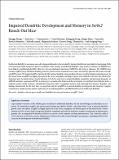| dc.contributor.author | Feliciano, C. | |
| dc.contributor.author | Itohara, S. | |
| dc.contributor.author | Dong, X. | |
| dc.contributor.author | Zhang, Qiangge | |
| dc.contributor.author | Gao, Xian | |
| dc.contributor.author | Li, Chenchen | |
| dc.contributor.author | Wang, Dongqing | |
| dc.contributor.author | Zhou, Dingxi | |
| dc.contributor.author | Mei, Yuan | |
| dc.contributor.author | Monteiro, Patricia | |
| dc.contributor.author | Anand, Michelle S. | |
| dc.contributor.author | Fu, Zhanyan | |
| dc.contributor.author | Feng, Guoping | |
| dc.date.accessioned | 2017-01-30T21:05:10Z | |
| dc.date.available | 2017-01-30T21:05:10Z | |
| dc.date.issued | 2016-02 | |
| dc.date.submitted | 2015-12 | |
| dc.identifier.issn | 0270-6474 | |
| dc.identifier.issn | 1529-2401 | |
| dc.identifier.uri | http://hdl.handle.net/1721.1/106797 | |
| dc.description.abstract | Intellectual disability is a common neurodevelopmental disorder characterized by impaired intellectual and adaptive functioning. Both environmental insults and genetic defects contribute to the etiology of intellectual disability. Copy number variations of SORBS2 have been linked to intellectual disability. However, the neurobiological function of SORBS2 in the brain is unknown. The SORBS2 gene encodes ArgBP2 (Arg/c-Abl kinase binding protein 2) protein in non-neuronal tissues and is alternatively spliced in the brain to encode nArgBP2 protein. We found nArgBP2 colocalized with F-actin at dendritic spines and growth cones in cultured hippocampal neurons. In the mouse brain, nArgBP2 was highly expressed in the cortex, amygdala, and hippocampus, and enriched in the outer one-third of the molecular layer in dentate gyrus. Genetic deletion of Sorbs2 in mice led to reduced dendritic complexity and decreased frequency of AMPAR-miniature spontaneous EPSCs in dentate gyrus granule cells. Behavioral characterization revealed that Sorbs2 deletion led to a reduced acoustic startle response, and defective long-term object recognition memory and contextual fear memory. Together, our findings demonstrate, for the first time, an important role for nArgBP2 in neuronal dendritic development and excitatory synaptic transmission, which may thus inform exploration of neurobiological basis of SORBS2 deficiency in intellectual disability. | en_US |
| dc.description.sponsorship | Massachusetts Institute of Technology. Poitras Center for Affective Disorders Research | en_US |
| dc.description.sponsorship | Broad Institute of MIT and Harvard. Stanley Center for Psychiatric Research | en_US |
| dc.description.sponsorship | National Institute of Mental Health (U.S.) (Grant R01MH081201to) | en_US |
| dc.description.sponsorship | China Scholarship Council (Graduate Fellowship) | en_US |
| dc.description.sponsorship | National Science Foundation (U.S.). Graduate Research Fellowship Program | en_US |
| dc.description.sponsorship | Harvard University | en_US |
| dc.description.sponsorship | Fundação para a Ciência e a Tecnologia (Portugal) (Doctoral Fellowship SFRH/BD/33894/2009) | en_US |
| dc.description.sponsorship | Brain & Behavior Research Foundation (National Institute of Mental Health Young Investigator Grant) | en_US |
| dc.description.sponsorship | Duke Institute for Brain Sciences | en_US |
| dc.language.iso | en_US | |
| dc.publisher | Society for Neuroscience | en_US |
| dc.relation.isversionof | http://dx.doi.org/10.1523/jneurosci.2528-15.2016 | en_US |
| dc.rights | Creative Commons Attribution 4.0 International License | en_US |
| dc.rights.uri | http://creativecommons.org/licenses/by/4.0/ | en_US |
| dc.source | Society for Neuroscience | en_US |
| dc.title | Impaired Dendritic Development and Memory in Sorbs2 Knock-Out Mice | en_US |
| dc.type | Article | en_US |
| dc.identifier.citation | Zhang, Q. et al. “Impaired Dendritic Development and Memory in Sorbs2 Knock-Out Mice.” Journal of Neuroscience 36.7 (2016): 2247–2260. | en_US |
| dc.contributor.department | Massachusetts Institute of Technology. Department of Brain and Cognitive Sciences | en_US |
| dc.contributor.department | McGovern Institute for Brain Research at MIT | en_US |
| dc.contributor.mitauthor | Zhang, Qiangge | |
| dc.contributor.mitauthor | Gao, Xian | |
| dc.contributor.mitauthor | Li, Chenchen | |
| dc.contributor.mitauthor | Wang, Dongqing | |
| dc.contributor.mitauthor | Zhou, Dingxi | |
| dc.contributor.mitauthor | Mei, Yuan | |
| dc.contributor.mitauthor | Monteiro, Patricia | |
| dc.contributor.mitauthor | Anand, Michelle S. | |
| dc.contributor.mitauthor | Fu, Zhanyan | |
| dc.contributor.mitauthor | Feng, Guoping | |
| dc.relation.journal | Journal of Neuroscience | en_US |
| dc.eprint.version | Final published version | en_US |
| dc.type.uri | http://purl.org/eprint/type/JournalArticle | en_US |
| eprint.status | http://purl.org/eprint/status/PeerReviewed | en_US |
| dspace.orderedauthors | Zhang, Q.; Gao, X.; Li, C.; Feliciano, C.; Wang, D.; Zhou, D.; Mei, Y.; Monteiro, P.; Anand, M.; Itohara, S.; Dong, X.; Fu, Z.; Feng, G. | en_US |
| dspace.embargo.terms | N | en_US |
| dc.identifier.orcid | https://orcid.org/0000-0002-1069-235X | |
| dc.identifier.orcid | https://orcid.org/0000-0002-3546-4740 | |
| dc.identifier.orcid | https://orcid.org/0000-0002-5596-1269 | |
| dc.identifier.orcid | https://orcid.org/0000-0003-3288-4560 | |
| dc.identifier.orcid | https://orcid.org/0000-0001-9473-2402 | |
| dc.identifier.orcid | https://orcid.org/0000-0002-8021-277X | |
| mit.license | PUBLISHER_CC | en_US |
| mit.metadata.status | Complete | |
